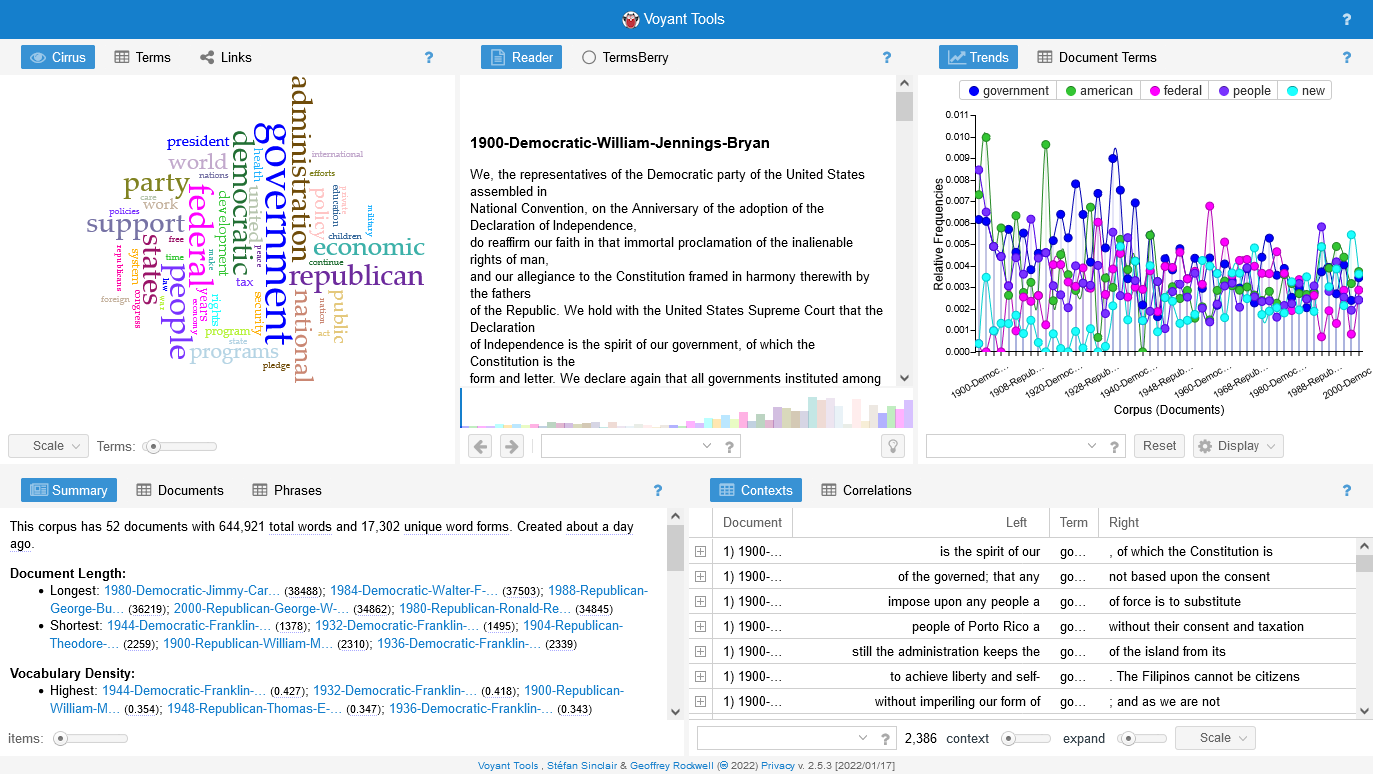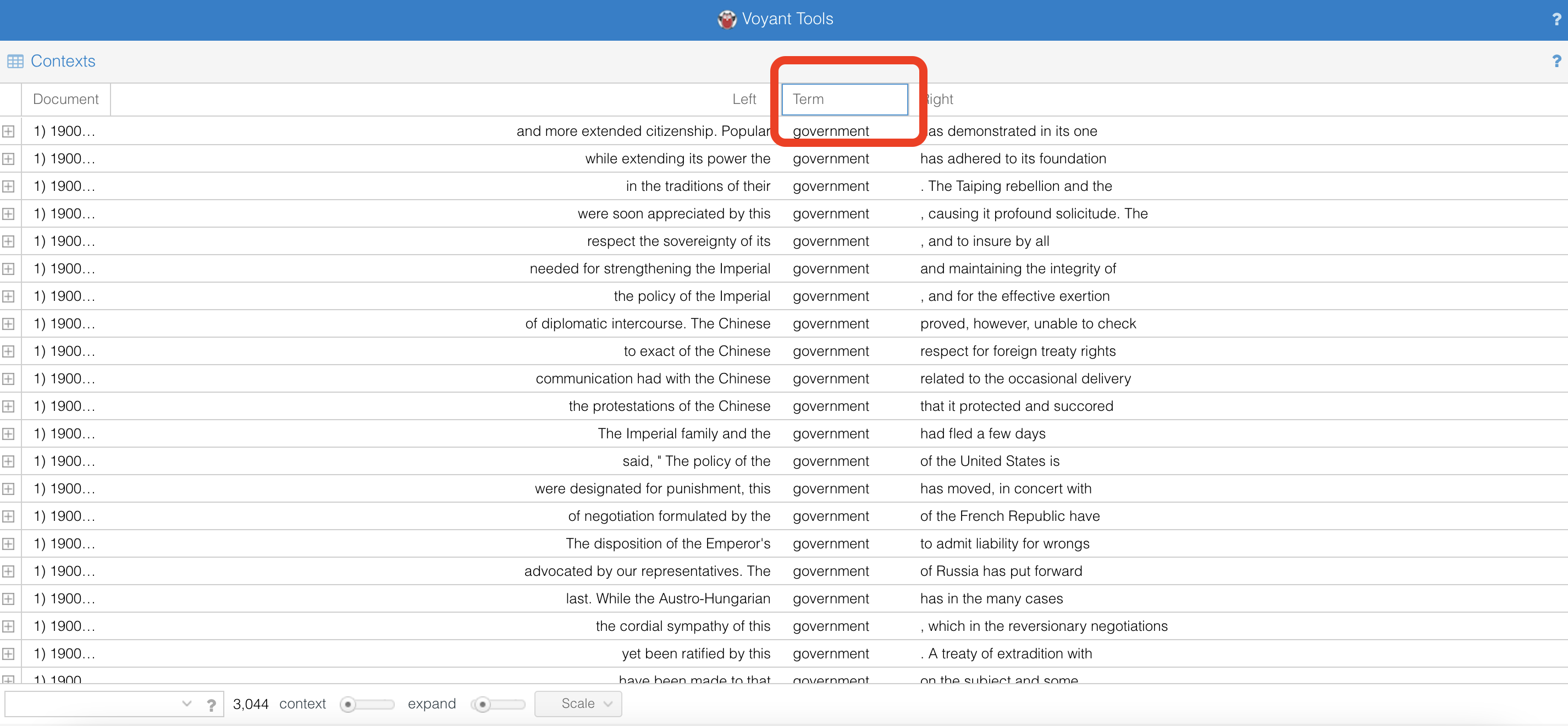Text Analysis With Voyant
Goals: Explore a corpus of text in Voyant; Use the Cirrus, Trends, and Context visualizations to make some observations about each corpus
Estimated Time to Complete: 30 minutes
Use Voyant to Explore Text
Last week, we learned about text analysis, a method of finding patterns across a large collection of texts by looking at characteristics like word frequency (how many times words appear) and word co-occurrence (what words appear near one another).
This week, we’re going to explore our two corpora of texts (20th-century State of the Union Address and Party Platform texts) using Voyant Tools and following the steps below.
Before we begin, however, a note on our data:
As you explore the visualizations in this activity, you might find that you want to read a president’s State of the Union Address or a candidate’s Party Platform in full. The 20th-century text we are working with was taken from UC Santa Barbara’s American Presidency Project site. To quickly access the full text of an Address or Platform statement on the American Presidency Project site, use this table: https://learn-static.github.io/text-analysis/data.html to search for the president/document in question, and click the corresponding link in the table to view the full text.
Step 1. Open a Corpus in Voyant
To walk through the steps in this tutorial, let’s use the State of the Union Addresses.
To open the 20th-century State of the Union Addresses in Voyant in a new browser tab, click on the green button below:
You’ve now opened a set of documents in the Voyant Tools platform. Your webpage will be broken into five different visualizations, looking something like this:

Step 2. What Am I Looking At?
Your instructors have separated each Address in our corpus of State of the Union Addresses into a separate document, then uploaded all of those documents at once into Voyant.
For example, Woodrow Wilson’s Address from 1917 is in a file titled 1917-Woodrow-Wilson, the text from Richard Nixon’s 1970 Address is in a file titled 1970-Richard-M-Nixon, etc.
Once these files are uploaded to Voyant, Voyant processes and visualizes them in several different ways, so you’ll see these file titles in the Voyant interface. Below, we’ll walk through four different visualizations.
Step 3. Word Clouds
Remember the “bag of words” approach we encountered last week, where a computer takes all the words from a corpus of documents in no particular order and counts the number of times they appear? Voyant uses this method to generate a word cloud, which shows the raw frequency of the top-appearing words in our corpus.
Look to the top left corner of your browser window. See all the colorful words jumbled together? That’s a word cloud. It contains the most frequently-appearing words in the corpus. The larger a word appears in the word cloud, the more frequently it appears across the documents in the corpus.
Let’s expand this visualization to take a closer look:
Hover your mouse just above the word cloud content, to the right of the “Links” button in the toolbar. Look for the icon of a box with an arrow pointing up and out of it. Click on this icon.

A popup will appear with the Title “Export.” Without clicking on any other options in the popup, click on the blue “Export” button in the bottom left of the popup.

This opens up the word cloud as a full-screen visualization in a new tab in your browser.
Take a look at the words in this word cloud. Do any surprise you?
Let’s adjust some parameters:
In the bottom left of the screen, find the slider to the right of the word “Terms.” Slide it to the right.
What happens? Is this change helpful? Slide it back to the left to view fewer words.
Right now you are viewing a word cloud that’s been generated from the entire 20th-century State of the Union Address corpus, by default. If you’d like to view a word cloud generated from just one or a few chosen documents in the corpus, you can click on the button in the bottom left of the browser screen that says “Scale.” A list of all the documents in the corpus will appear. Click one or more documents you’d like to see combined into a word cloud.
Do the words change much depending on the documents you select?
To go back to viewing a word cloud created from the entire corpus, click on the “Scale” button again, and select the “Corpus” option. This will regenerate the word cloud from the full corpus.
Switch back over to your original Voyant browser tab (or click the green “State of the Union Addresses” button above again) to get back to the Voyant home screen.
Step 4. Word Trends Over Time
On the Voyant home screen, find the “Trends” visualization in the top right corner of the browser window.
Hover your mouse in the toolbar just above the visualization, next to the “Document Terms” button, until you see the icon of a box with an arrow pointing up and out of it. Click on this icon.

A popup will appear with the Title “Export.” Without clicking on any other options in the popup, click on the blue “Export” button in the bottom left of the popup.

This opens up the Trends graph as a full-screen visualization.
Relative Frequencies
The Trends graph shows you the relative frequencies of words used over time. Remember relative frequency from last week? Relative frequency is the number of times a word appears in a text, relative to the size of that text. This is in comparison to raw frequency, which is the number of times a word appears in a text. When we looked at our word cloud, we were looking at raw frequency. When we look at this Trends graph, we are looking at relative frequency, or the relative number of times a word appears in each of the texts in our corpus.
View New Terms
Voyant gives us some default terms to visualize at first, but you probably have other terms you’d like to visualize besides the default terms that Voyant chose for you. Let’s get rid of the default terms and enter some words we’d like to investigate.
- Look in the very bottom left corner of your browser window and locate the blank text box with a dropdown to the right of it.
- Click into the text box.
- A list will pop up above the text box that contains all the terms currently on the graph.
- Ignore this list and type in your own term. For instance, type the word “war” into this box.
- You’ll see a list of options for war appear in the list above the text box. Click on the very top option (war*). The asterisk is a wildcard symbol that tells Voyant to select not only the word “war,” but also any words that start with the letters w-a-r.
Once you’ve chosen war, your graph should change so that the only word at the top is “war*”. Let’s add another word:
- Without deleting “war*”, click into the text box in the bottom left corner of the browser window again.
- This time, type in the word “peace.”
- Select “peace*”.
- Now analyze your graph:
- Do the speakers that use the term war most frequently also use the term peace most frequently?
- Do these two terms often appear together, or do they peak at different points throughout the century?
To get rid of the terms war and peace, click on the “x” that appears to the right of each of them in the text box.
Add your own words to the text box and have fun exploring! Keep your word cloud in mind–do any of the words that appear in the word cloud display surprising patterns in the Trends graph?
Note that if you’d like to visualize the data in a format other than a line graph you can click on the button titled “Display” in the bottom left corner of the browser window, and select from any of the graph options that appear. You can also reset the Trends graph to the default words Voyant chose for you by clicking on the “Reset” button in the bottom left corner of the browser window.
After you’ve explored, switch back over to your original Voyant browser tab (or click the green “State of the Union Addresses” button above) to get back to the Voyant home screen.
Step 5. Contexts
On the Voyant home screen, find the “Contexts” visualization in the bottom right corner of the browser window.
Hover your mouse in the toolbar just above the visualization, next to the “Correlations” button, until you see the icon of a box with an arrow pointing up and out of it. Click on this icon.

A popup will appear with the Title “Export.” Without clicking on any other options in the popup, click on the blue “Export” button in the bottom left of the popup.

This opens up Contexts as a full-screen visualization.
The Contexts tool shows each occurrence of a word along with its surrounding text (its “context”).
By default, Voyant shows the context of the most frequent word in a corpus, but you can switch this out for a word of your choosing. The word is situated in the middle column (the column titled “Term”) of the visualization. Note you may need to expand this column to view the entire word, which sometimes gets cut off if the column is not wide enough.

To look at the context of a word of your choosing:
- Look in the very bottom left corner of your browser window and locate the blank text box with a dropdown to the right of it.
- Click into the text box. A list will pop up above the text box that contains all the terms currently on the graph. The words in this list appear most frequently in the corpus. You can choose a word from this list or type in your own word.
- To continue with our earlier example, type the word “war” into this box. You’ll see a list of options for war appear in the list above the text box.
- Click on the very top option (war*). The asterisk is a wildcard symbol that tells Voyant to select not only the word “war,” but also any words that start with the letters “war.”
Now “war” should appear in your “Terms” column. You are looking at every instance that “war” appears in a document, along with its surrounding text. In the column titled “Left” are the five words that appear before the word “war,” and in the column titled “Right” are the five words that appear after it. In the left-most column, titled “Document,” you’ll see the name of the document where each occurrence of “war” appears.
To switch out the term “war” with another word, in the text box at the bottom left of your browser window click on the “x” that appears to the right of the word “war.” Add your own words to the text box and have fun exploring!
Switch back over to your original Voyant browser tab (or click the green “State of the Union Addresses” button above) to get back to the Voyant home screen.
Step 6. Explore
Now that you know how to read and manipulate Voyant’s default visualizations, use Voyant to analyze and explore the 20th-century State of the Union Addresses and Party Platforms (click on the green buttons below to access these documents in Voyant).
In addition to the visualizations we walked through above, you are also welcome to explore one of Voyant’s many other visualizations, documented here: https://voyant-tools.org/docs/#!/guide/tools.